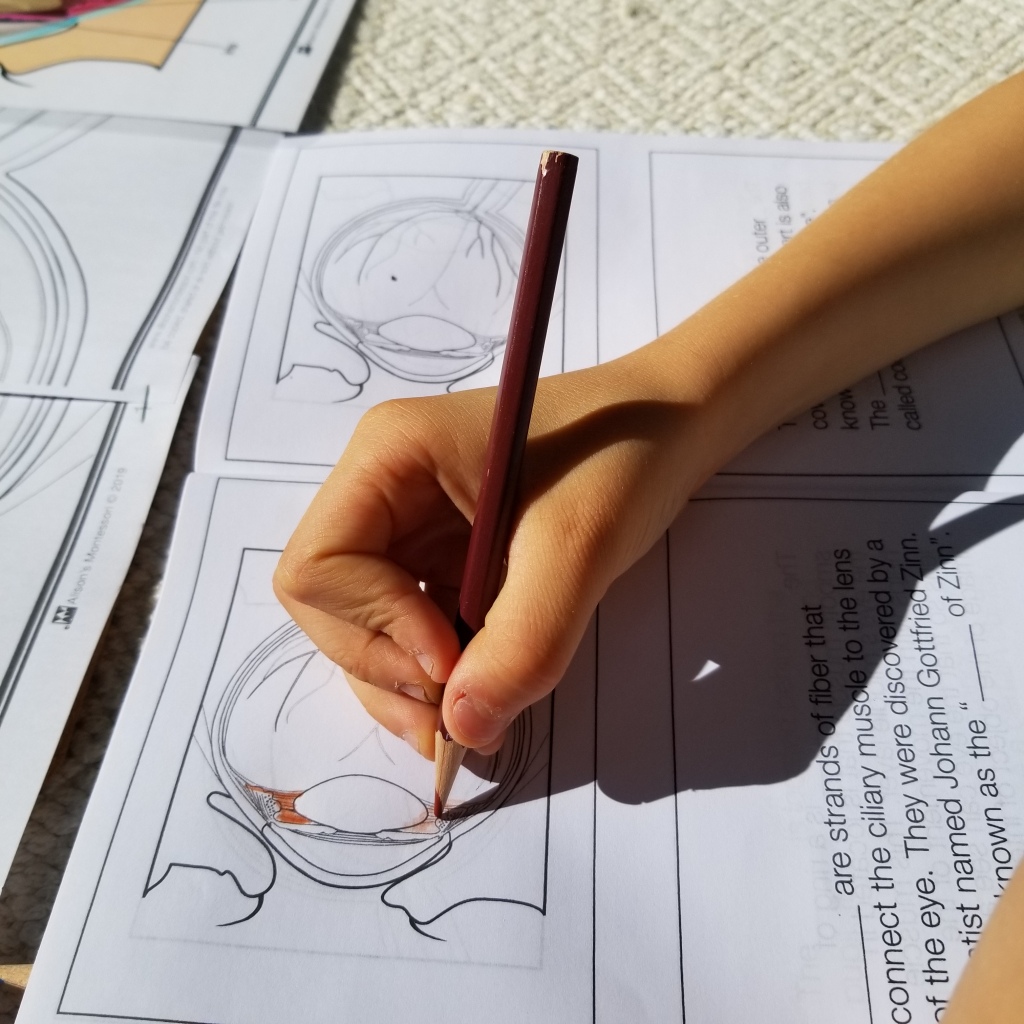Biology, Anatomy 6-9

Alison’s Montessori is creating a series of unique science puzzles. Recently, the focus has been on organs. I would like to share with you the Parts of a Human Eye Puzzle. Do you have small models for showing 3D organs? So do I, but after using a few puzzles on complex organs such as the eye, I realized I actually don’t know much about them.
Because the puzzle is sharply cut, Alison’s Montessori is able to separate every essential part of an organ. If you look at the Sclero, Choroid, and Retina, these are very thin layers. Children see them as one block, regardless of the labels.

If you look at the picture below, you can see how we were able to deconstruct every single part of the eye from the cornea, to the optic nerve. We are talking about 10-11 layers here, in one eye ball!
I added a 3D model of the eye to emphasize that the vitreous humor (chamber filled with gel-like substance) which takes up an important space in the organ.
Materials
The Parts of an Human Eye puzzle in conjunction with the nomenclature cards consists of:
- A 25 piece wooden puzzle with ridges for easy lifting
- wooden labeled arrows corresponding to each part of an eye
- A colorful puzzle control chart
- 2 sets of 3 part cards to offer children challenges
- A booklet to control the 3 part cards
- A workbook as extension (reproductible!)
- Blackline diagram to make copies of the human eye from children to color and label
- A control chart for the blackline diagram
- Optional: foam model of a human eye
- Optional: plastic model of a human eye




How it works
- We talked about vision and what it means. We looked deep in the woods, then close to us. We remembered testing our vision at the doctor’s, and used a letter test vision to test our vision. We talked about nutritious food that promotes healthy eyes, and what habits have positive and negative effects on the eyes.


- We then started to label the puzzle using the wooden arrows and the control chart.
- We laid out the arrows in a linear fashion, and began to read the parts functions on the booklet. As we read, we took the part in question, and placed it above the wooden label.
- We then played with the puzzle, and explored the models.

Booklet for control 
Reproductible Workbook
- We ended the lesson by coloring in the workbook the parts individually.
- We might continue the next days with filling the blanks on the workbook, labeling and coloring the diagram, working with the nomenclature cards, etc…

Vision Test 
Large Environment propitious for Vision
Again, this is an amazing material that has children and adults alike learn about organs on a higher level. If you have younger learners, Alison’s Montessori offers a set of Nomenclature Cards for age 3-6. All these materials are made in the U.S.


Disclosure: this experience was made possible thanks to Alison’s Montessori for having the confidence in their house-made products, and letting us try the puzzle at no cost, with no requirement on my part. I do write unbiased honest reviews, because I only write about products that work for us.

Ready for a lesson? Please subscribe to receive an a notification on the next review, and stay informed!





How timely. As a virgin home school mom forced into it by the pandemic, I planned a botany curriculum to start the year. 12 hours before our first day my littlest one muttered “How does my eyeball work”… I knew that meant I had to take a different path. This post has saved me, thank you!
LikeLiked by 1 person
Debbie, thank you for your comment ! We just used the lesson again, and we understood more information than the first time. We went back and forth between deconstructing the puzzle and the 3D model. I think the combination of both is perfect for depth understanding. We will go test the “blind spot” now! I need some info on this 😉 thanks again, happy my post was helpful!
LikeLike